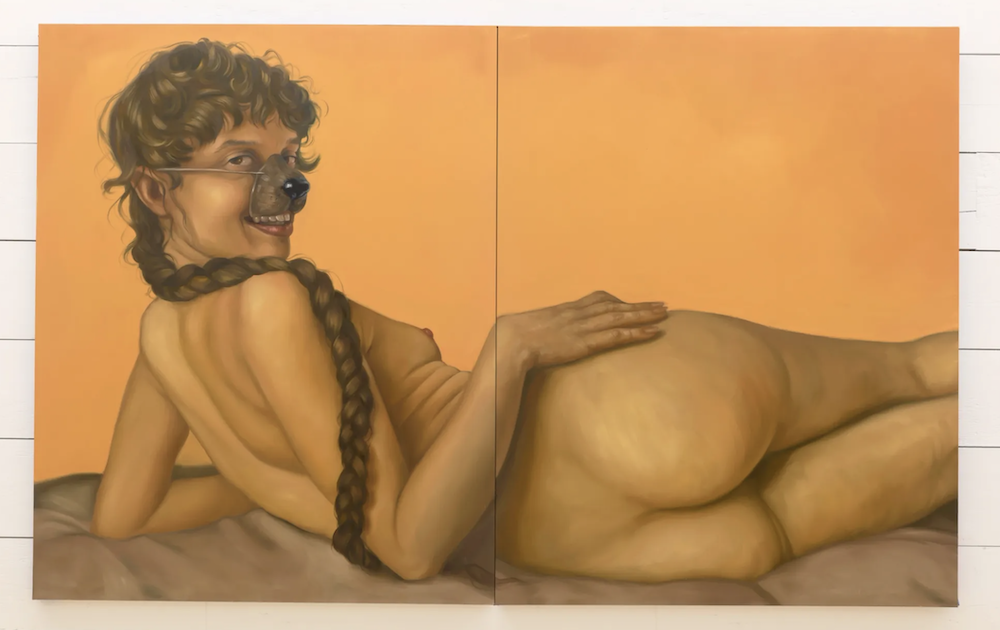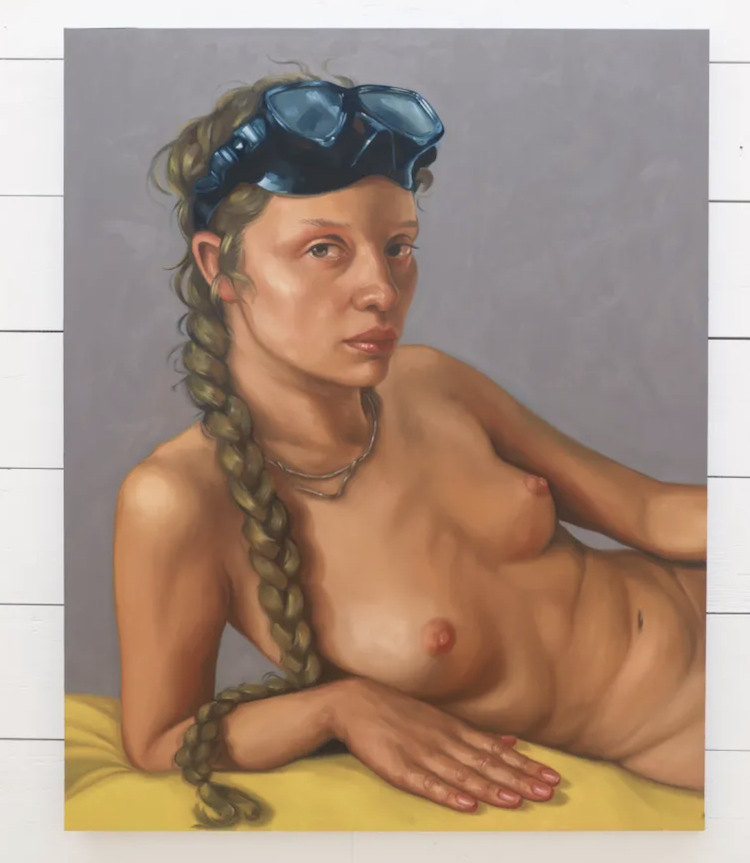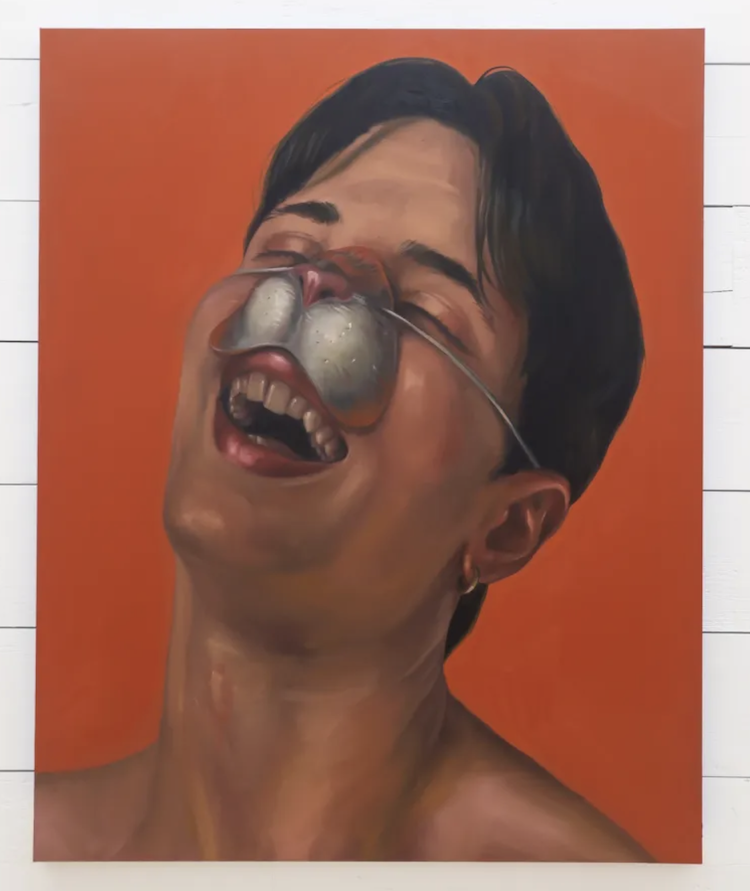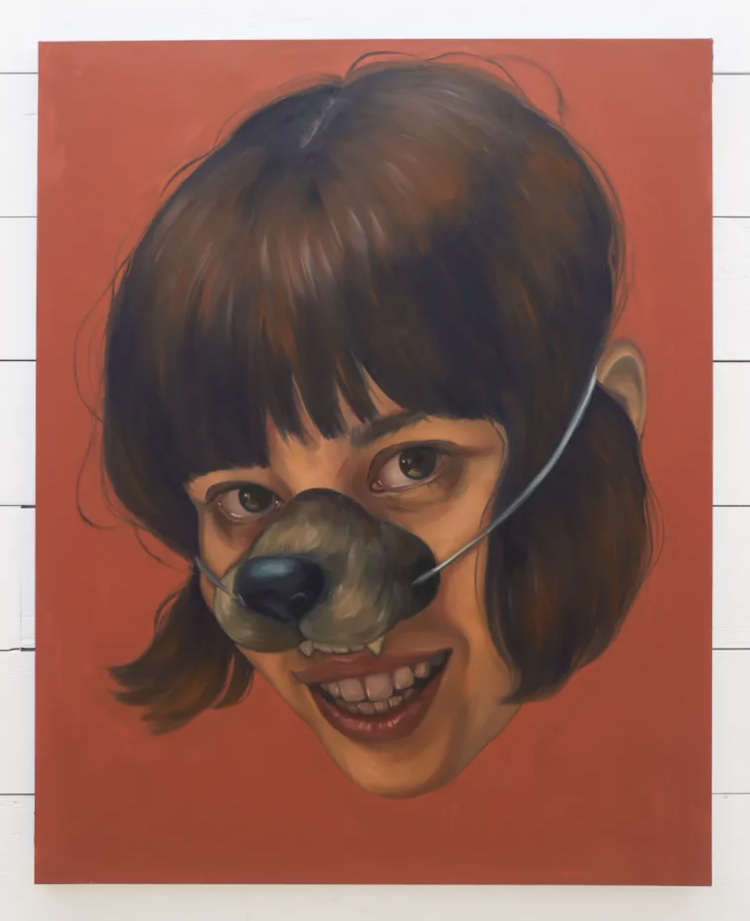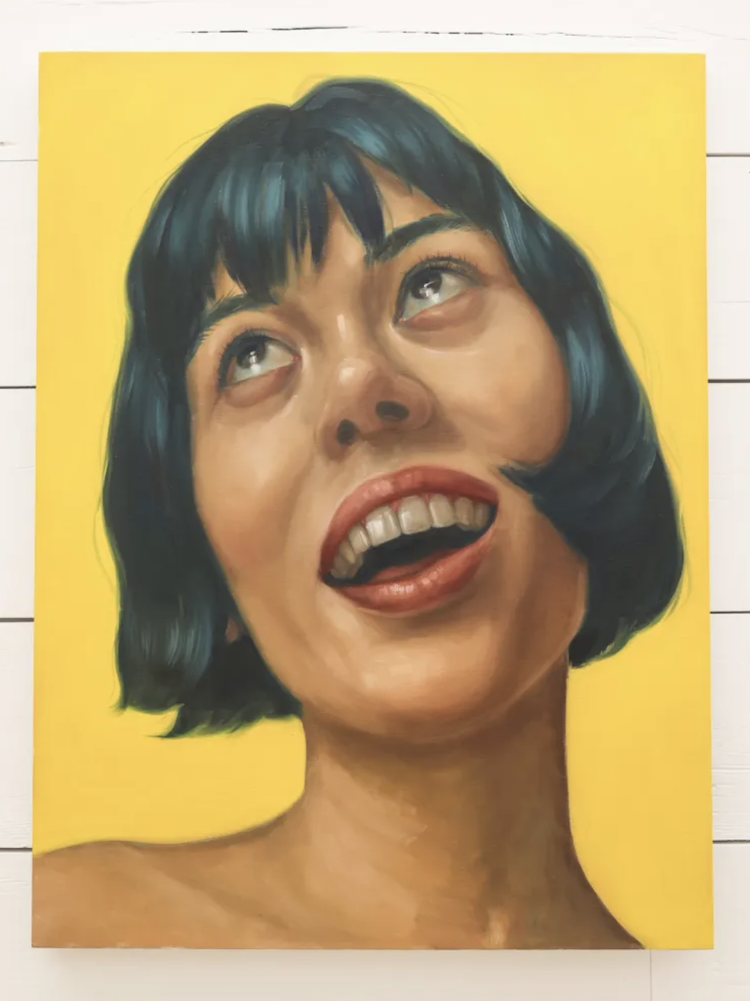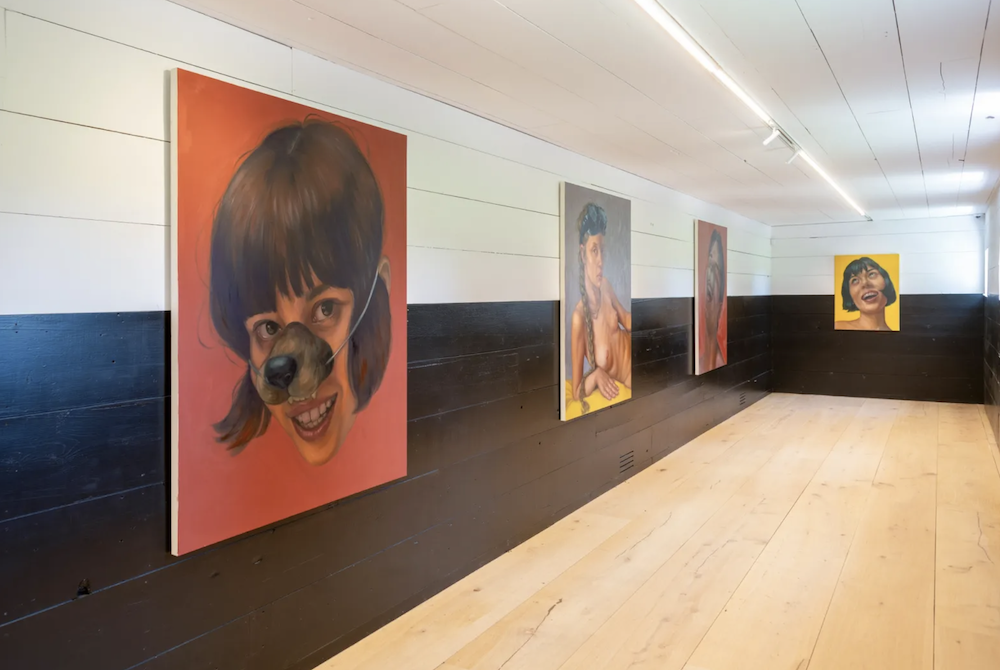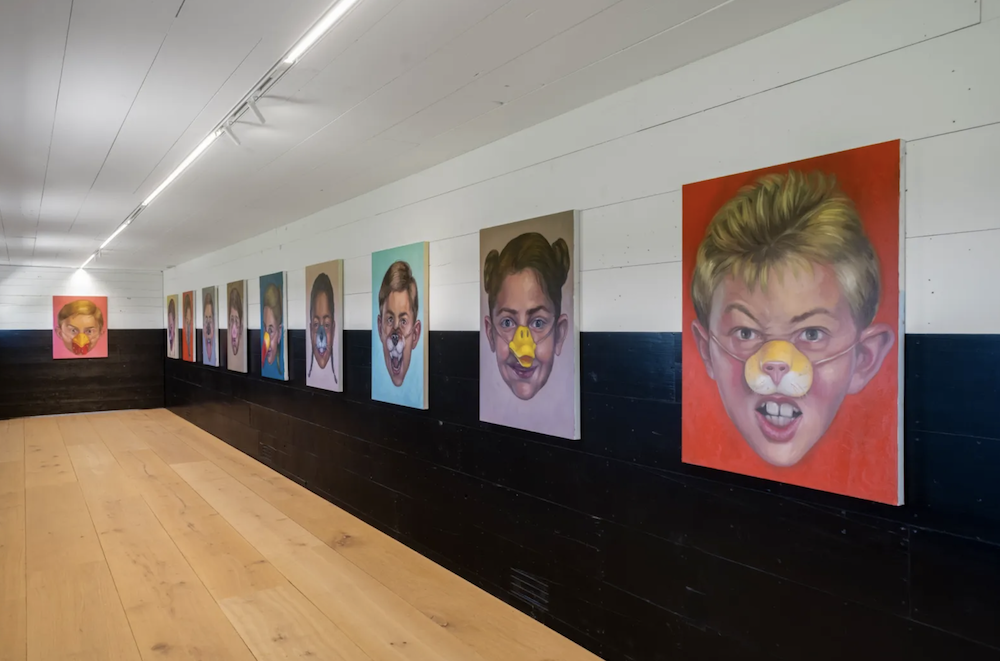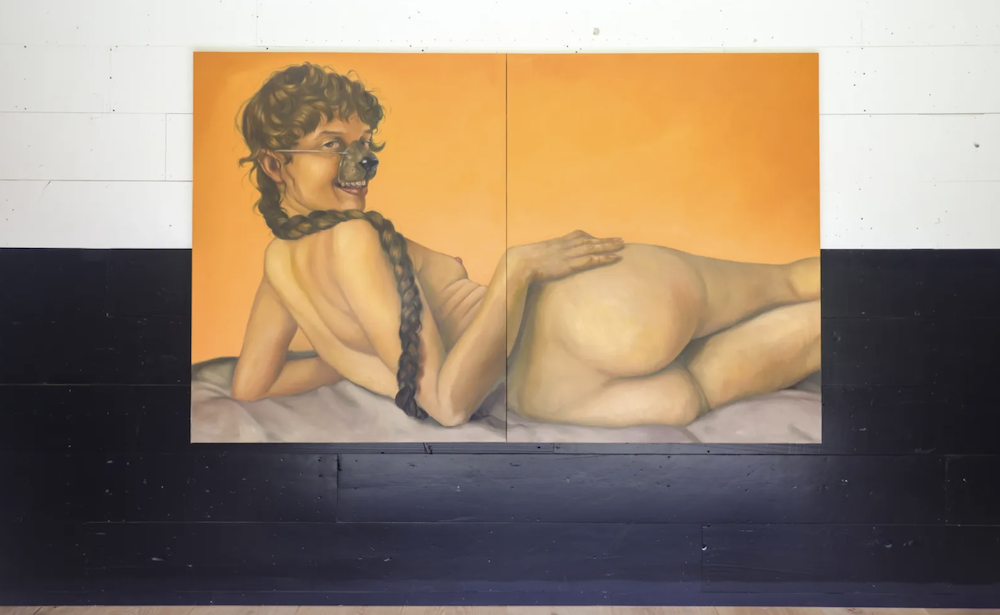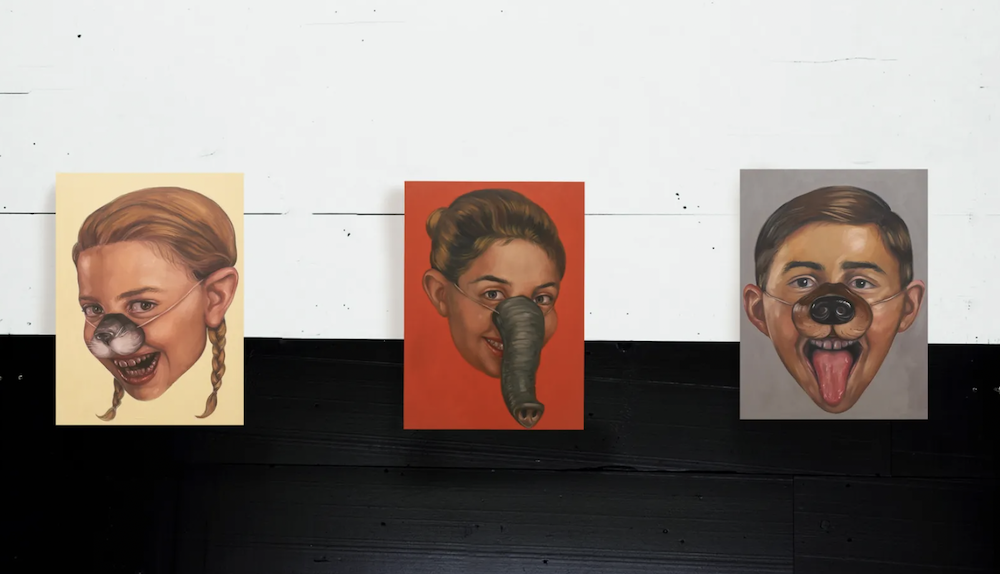The Ranch is pleased to announce Natural Causes, a solo exhibition of new paintings by Chloe Wise. The show will run through August 10, 2023, in the West Barn Side Galleries. Large-scale paintings accompanying the exhibition at The Ranch will inaugurate the opening of the gallery’s new venue at Gosman’s dock in Montauk, NY.
“When my face is flushed with blood, it becomes red and obscene. It betrays, at the same time, through morbid reflexes, a bloody erection and a demanding thirst for decency and criminal debauchery. For that reason, I am not afraid to affirm that my face is a scandal.” ––Georges Bataille, L’Anus Solaire, 1931
There’s something to Georges Bataille’s self-conscious confession––on the tangle of shame and sordid perversion that the face cannot but betray––that sounds out in recent portraits by Chloe Wise. In Natural Causes, a show comprised primarily of paintings of figures donning animal masks, the temptation of fantasy comingles with the desire for adolescent purity. Known for her meticulous yet redolent depictions of her immediate milieu or still lifes that consider consumption and consumerism, Wise seizes on a less typical thematic in this body of work. Taking a razor to the intersecting coordinates of performance, play, and pretend, she draws out the psychological armature and protocols of the make-believe. A nod to our primal instincts, dressing up as an animal is a ritual undertaken at designated holidays or incorporated into erotic roleplaying. Addressing this phenomenon, Wise intersperses an assortment of portraits of her adult friends, nude but for the masks (camp naivete tinged with self-awareness). For the children’s portraits, Wise borrows impish faces from stock photos found on a Halloween costume website––joining ambiguous, detached reference with the homespun and intimate. Immediately, these paintings enter Bataille’s paradox: they grasp for decency with the same hand that coaxes debauchery.
Making portraits of this kind of parodic (oftentimes tawdry) play, Wise examines what it means to take seriously these flimsy attempts at self-transformation. To be sure, there is much at stake in this gesture: temporary anonymity, compensatory escapism, diversion. On the other side of the coin, there skulks willing debasement, body dysmorphia, sexual humiliation. But what these portraits certainly enact is the suspension of disbelief––literalizing this concept by presenting each as a floating head unmoored from both body and background. To this point, the subjects unabashedly parade their thinly veiled disguises. Many sport a plastered grin that evidences none of the scandal that plagued Bataille. Others contort their faces to further masquerade as the animal of their choosing. A young boy with hair combed over puffs out his cheeks, miming a bloated physicality that offers up the linguistic connotation of “pig.” Another still opens his mouth to roar like a wild animal. It seems relevant to note that the young girls convey furtive glances and coquettish tilts of the head, as if more squarely acknowledging the farcical rouse underfoot. The subjects’ undeterred confidence attests to a naïve faith: in regulated settings or on ordained occasions, we are permitted to make-believe.
While unmissably contemporary, the masked portraits wedge this act of self-presentation into the sweeping history of the portrait. The genre’s conventional application extends the promise of accurate representation. Fealty to the depicted entails the artist provide markers of identity, insights into personality. For Wise, animal masks lend a fast and loose way of taxonomizing the sitter. Barely even
covering the nose, these feeble attempts at animi nevertheless satisfy the societal drive to categorize and compartmentalize––route ways of structuring and hierarchizing. Not only is information about the sitter obtained by decoding the given attributes, but the subject also constructs their identity out of these visual cues. A pair of quixotic portraits of scuba divers accents this point. Recent anthropological studies of scuba explain diving as a transcendence of human conditions and terrestrial limitations. Possibility is up for grabs for the duration of the dive––immersion in an alternate reality, the adoption of superhuman capabilities, even the reversion to amniotic fluid amid the limitless blue. Here, we both exceed and regress––coming to understand life from a “bottom-up lived experience.” This is the same cultural reversal that results from bearing animal noses. The wearer retires human codes of comportment and civility; they descend to a horizontal rung of collectivism found among animals that voids the values and individualism of what is termed “vertical culture.”
By extension, visual disguise liberates repressed urges––allowing a socially acceptable pretext for misbehavior broadly construed. At the same time, these activities are rigorously monitored. Like any game, dress-up is regulated by rules and procedures enforced by overseers. As Wise points out, structured leisure like elementary school recess exists to instruct and fatigue into compliance. In the end, play conversely produces citizens more docile and pliable. All of this finds visual expression in the uniform format of the series and its presentation in an ordered row. Even while Wise directs us to the Foucauldian politics of play as controlled intervention, she also reminds that these rituals pry open the irrational and ecstatic. With subtly undone expressions––slightly crossed eyes, agape mouths, tongues pressed against teeth––each portrayal intimates that the subject might just slip into the absurd. In Wise’s rhetoric, play both tames and encourages transgressive impulses.
An unresolved tension persists amid these avowedly buoyant portraits in their mélange of bright colors and cheery subjects. Equally important to the act of putting on the mask is the culminating moment when it is taken off––this return to homeostasis typically coincides with physical relief as the constricting plastic visor and ties are removed. Wise denies this gratification. Instead, the artist insistently revisits the apex of the masked performance, transmuting the finite activity into the infinite. It is in this stalled pleasure that Wise sardonically pulls apart the mechanisms that chasten play and the covenants that presuppose the seriousness of portraiture. ––Megan Kincaid



